Regional employment patterns in Scotland: statistics from the Annual Population Survey 2018
Summary publication of results from the Annual Population Survey 2018, presenting analysis on the labour market, education and training.
This document is part of a collection
Section 5: Unemployment
5.1 Unemployment over time
Who is classed as unemployed under the ILO definition?
People aged 16 and over who are not in employment, would like a job, have actively sought work in the previous four weeks prior to their LFS interview and are available to start work within the next fortnight; or are out of work and have accepted a job which they are waiting to start in the fortnight following their LFS interview.
Chart 28: Unemployment Rate (16+), Scotland and UK
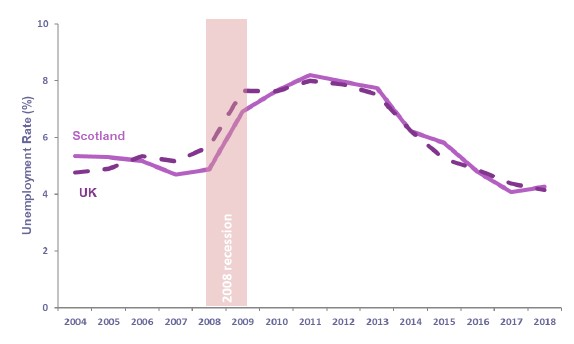
Scotland’s unemployment level and rate increased over the past year.
The unemployment rate in Scotland in 2018 was 4.3 per cent, higher than the UK rate of 4.2 per cent.
Over the year, the rate has increased in Scotland (up 0.2 percentage points) and decreased in the UK (down 0.2 percentage points).
Scotland’s unemployment rate has decreased by 0.6 percentage points since 2008 while it decreased by 1.5 percentage points in the UK.
There were 117,200 people aged 16 and over who were unemployed in Scotland, an increase of 5,300 over the year. This was due to an increase in the number of women who were unemployed, up 5,900 over the year.
5.2 Local authorities
Model Based Unemployment (MBU) Rates have decreased in 28 of Scotland’s 32 local authorities since 2008
In 2018, the highest MBU rates were seen in Dundee City (6.5 per cent), Glasgow City (5.9 per cent), East Ayrshire (5.8 per cent), North Ayrshire (5.7 per cent) and Inverclyde (5.3 per cent). The lowest rates were seen in Orkney Islands (1.8 per cent), Shetland Islands (2.1 per cent), Na h-Eileanan Siar (2.6 per cent), Aberdeenshire (2.8 per cent) and Argyll and Bute (2.9 per cent).
Since 2008, MBU rates decreased in 28 of the 32 local authority areas while 3 saw an increase in their unemployment rates and one remained unchanged.
Statistically significant decreases between 2008 and 2018 were seen in West Dunbartonshire (down 2.2 percentage points from 6.8 per cent to 4.6 per cent), Na h-Eileanan Siar (down 1.7 percentage points from 4.3 per cent to 2.6 per cent), Dumfries and Galloway (down 1.6 percentage points from 4.6 per cent to 3.0 per cent), Argyll and Bute (down 1.4 percentage points from 4.3 per cent to 2.9 per cent) and Aberdeen City (up 1.5 percentage points from 3.6 per cent to 5.1 per cent).
Note: Sample sizes for the unemployed cohort are relatively small compared to the employed or inactive cohorts. Consequently unemployment estimates at local level can have large sampling variations. To improve the quality of estimates for all local authorities, the Office for National Statistics (ONS) developed model based estimates.
Figure 8: Model Based Unemployment Rate 2018 16 year olds and over (per cent)
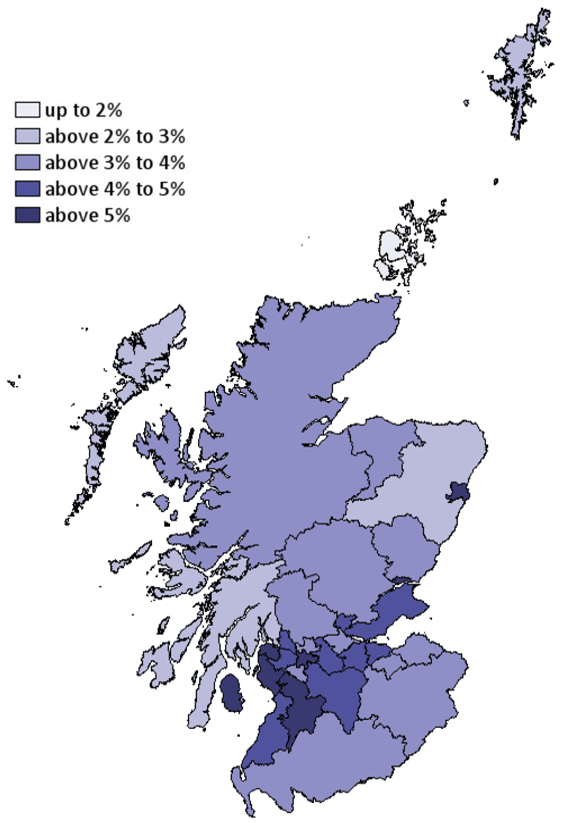
5.3 Gender and age
The unemployment (16+) rate for women in Scotland increased by 0.4 percentage points from 3.5 per cent in 2017 to 3.9 per cent in 2018, while the unemployment rate for men was 4.6 per cent in 2018, decreasing slightly (0.1 percentage points) over the year.
Chart 29: unemployment Rate (16+) by Gender, Scotland
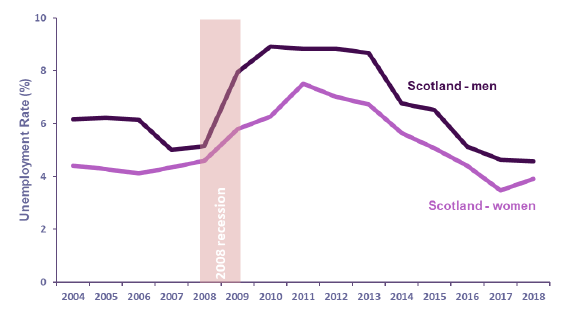
Since 2008, the unemployment (16+) rate for women in Scotland decreased by 0.7 percentage points from 4.6 per cent to 3.9 per cent in 2018, while the unemployment rate for men also decreased from 5.1 per cent to 4.6 per cent (0.6 percentage point decrease) over the same period.
The youth unemployment rate in Scotland increased by 0.4 percentage points over the year to 9.6 per cent in 2018
The youth (16-24) unemployment rate in Scotland is the highest of all age groups at 9.6 per cent (lower than the UK rate of 11.6 per cent).
The youth unemployment rate in Scotland increased by 0.4 percentage points over the year and decreased by 3.9 percentage points since 2008, while the UK rate has decreased by 3.4 percentage points since 2008 and by 0.5 percentage points over the year.
Unemployment rates continued to fall for the 35-49 age group (to 2.9 per cent in 2018) and increased over the year to 4.7 per cent for the 25-34 age group.
Chart 30: Unemployment Level (16+) by Age, Scotland
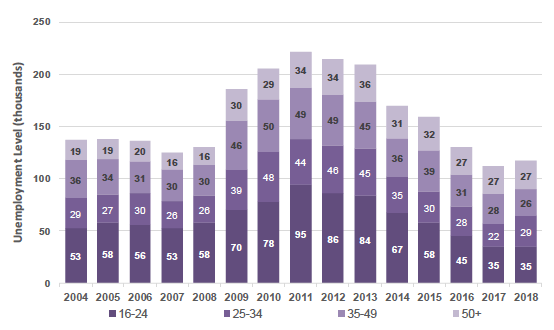
5.4 Duration
41.8 per cent of all une mployed people (16+) in Scotland have been unemployed for 6 months or more
Of the 117,200 unemployed people in Scotland in 2018, 67,500 (58.2%) were unemployed for less than six months.
The proportion that have been unemployed for less than 6 months has decreased by 10.0 percentage points since 2008, indicating a shift to lengthier durations of unemployment.
Chart 31: Proportion of people (16+) who are unemployed by duration of unemployment, Scotland
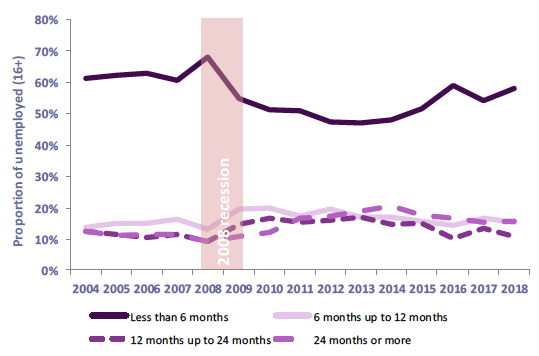
Chart 32: Proportion of people (16+) who are unemployed by duration and age, Scotland
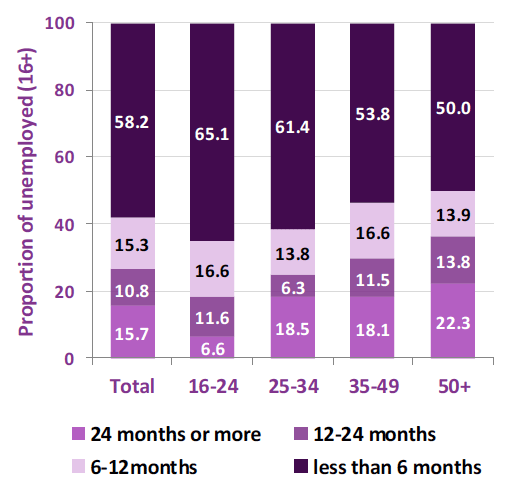
The 16-24 age group are least likely to be unemployed for more than 12 months (18.3 per cent), while those aged 50+ are most likely to be unemployed for 12 months or more (36.1 per cent).
5.5 NEET
8.4 per cent of people aged 16-19 years were not in employment, education or training (NEET) in 2018, a decrease of 0.1 percentage points from 2017 and a decrease of 4.8 percentage points* from 13.2 per cent in 2010 (peak following the recession).
The percentage of 16-19 year olds who are not in employment, education or training has typically been higher for men than women. However, the rate for women has increased over the year by 3.0 percentage points to 10.4 per cent in 2018 to become higher than the rate for men.
Chart 33: Percentage of 16-19 year olds who are not in employment, education or training since 2004 by gender, Scotland
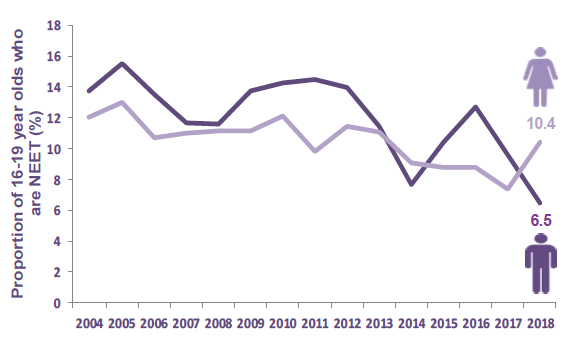
Chart 34: Percentage of 16-19 year olds who are not in employment, education or training since 2004 by age, Scotland
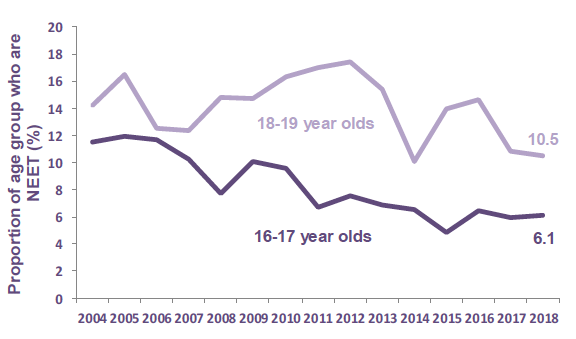
The percentage of those who are not in employment, education or training is higher for those aged 18-19 (10.5 per cent) compared to those aged 16-17 (6.1 per cent).
Of the 19,000 people aged 16-19 in 2018 who were not in employment education or training, 7,000 were aged 16-17 and 12,000 were aged 18-19.
Table 3: Not in employment, education or training level, 2018
| Age | Gender | ||
|---|---|---|---|
| 16-17 | 7,000 | Men | 7,000 |
| 18-19 | 12,000 | Women | 12,000 |
| All (16-19) | 19,000 | All | 19,000 |
* Statistically significant
Contact
If you have any enquiries relating to Labour Market Statistics then please contact us at:
Email: LMStats@gov.scot
Telephone: 0131 244 6773
Fax: 0300 244 1060
Post:
Labour Market Statistics
OCEAES: Economic Strategy and Policy
Scottish Government
5th Floor
5 Atlantic Quay
150 Broomielaw
Glasgow
G2 8LU
We welcome any comments on both the format and content of the website, including any problems you may encounter.
You may also contact the Statistician Group Enquiries for general information.
There is a problem
Thanks for your feedback